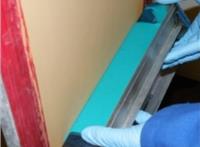 Add My Company
Add My Company
Sign In

Screen Printing 101 Hints & Tips: How To Coat Screen Printing Emulsions By Hand
Consistent and good quality coating of the mesh is the key to the quality of the finished print. In this short guide you will learn how to successfully coat with a photostencil emulsion by hand.
Prior to coating any mesh, it is important that you degrease your mesh.
Important
It can never be emphasised enough just how important thorough mesh preparation is. It should be looked upon as one of the basic ground rules when producing stencils.
Failure to pretreat mesh can lead to costly breakdown and screen re-coating in production, which can easily be avoided by taking these few extra and inexpensive minutes at the very beginning.
Coating Troughs
It is essential to use a good quality coating trough if you want to achieve a consistent result. The edge of the trough must be straight with no 'nicks' or other damage. The profile of the edge will influence the amount of emulsion deposited with a sharp edged trough depositing less than a rounded edged trough. In general it is better to select a rounded edged trough as this is slightly more resistant to edge damage. The trough should be tough enough not to flex during use and be able to stand upright when full of emulsion. A lid to the trough can help reduce airborne contamination and slow down drying in the trough.
Coating Basics
The objective of emulsion coating is to deposit an even, blemish free coating in a reproducible way. This can only be achieved if the following parameters are controlled: coating angle/pressure/speed and more surprisingly emulsion level in the trough.
Angle
The coating angle will affect the volume of liquid deposited. Too acute an angle and the trough shoulders will bow the mesh, too great an angle and the trough will scrape rather than coat.
Pressure
The coating pressure will affect the volume of liquid deposited. Too high a pressure could potentially damage the mesh whereas too little pressure will lead to uneven coating as the trough does not 'meter' the emulsion.
Speed
Too fast a coating speed will lead to air bubbles due to incomplete encapsulation of the mesh fibres - especially on coarse mesh counts <77/cm (<200/inch). Whereas too slow a speed could lead to high coating thickness due to excessive push through of the emulsion.
The picture opposite shows how the air bubbles have been trapped on the 'lee' of each fibre during coating. This will create a weak area that is likely to pinhole on long runs
Top Tips
Whatever coating regime you choose always finish off the initial wet on wet coatings from the squeegee side. This will ensure that the wet coating is pushed through to the print side where you want it leaving just a thin layer on the squeegee side to provide the durability.
Low mesh tension can cause an uneven coating of the emulsion. When using a mesh that has low tension you will need to increase the coating pressure or replace the mesh if you want to avoid an uneven or patchy looking stencil.
Coating troughs the same width as the screen can cause an uneven coating of the emulsion, this is typically represented by a thin coating at the edges and a thicker coating in the middle.
Uneven pressure during coating can cause a patchy stencil and an uneven coating profile.
Always coat emulsions on a mesh that has been pre-degreased and is thoroughly dry.
Dry screens horizontally as drying them vertically can cause the stencil to look patchy.
How To Coat Emulsion By Hand
When coating manually it is very important that the screen is held firmly. A simple coating stand can help significantly. The screen should be held vertically, angled slightly away from the operator.
Depending on the size and shape of the coating trough it can be held either at the ends or by the body. Ensure that the trough is level and even pressure is applied across its length. Try to keep a constant coating angle for the coating trough lip. It is important that the trough does not ride over the edge of the frame or onto a high build adhesive overlay otherwise this will lead to thick edges.
It is important not to have the screen too high as this could affect the trough lip angle in the upper part of the screen. Typically the top of the screen should be no higher than your chest.
Ensure that there is no loose clothing (or hair) which could come into contact with the wet emulsion or that the screen is positioned too low for comfort.
For more information on How To Coat Emulsions By Hand talk to CPS - Chemical Products and Services
Enquire Now
More related to How To Coat Emulsions By Hand
List your company on FindTheNeedle.
